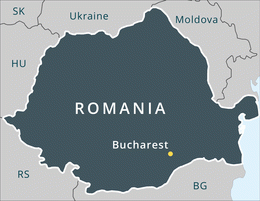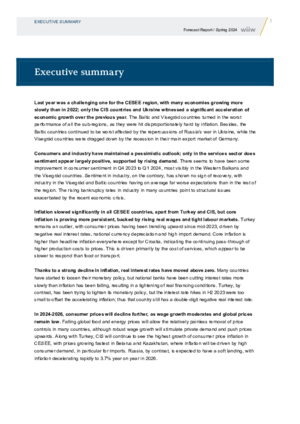Romania

Romania’s economic growth has declined over the past few quarters, resulting in a modest expansion of 1.2% for 2024 as a whole. This slowdown has occurred despite robust wage growth and significant fiscal spending – which bolstered household consumption, but also exacerbated external deficits. The fiscal strategy for 2025 seeks to reduce the general budget deficit to 7% of GDP (from about 8.2% in 2024). However, it will be a challenge to achieve this target, as the proposed measures – such as freezing public-sector wages – focus primarily on curbing expenditure. Romania’s recent history of inconsistent adherence to fiscal rules raises further concerns. The higher cost of deficit financing on international markets and the conditions linked to accessing EU funds may necessitate tax rises in H2 2025. Nevertheless, domestic consumption is expected to remain strong, driven by a hike in the minimum wage and the ongoing impact of the pension reform introduced in September 2024. If export markets recover, if agriculture is not faced with extreme weather conditions and if EU funds are disbursed in a timely manner to support investment, GDP growth could reach 2.2% in 2025. Romania’s accession to the Schengen Area in 2025 is expected to enhance its competitiveness by reducing cross-border transaction costs. However, inflationary pressure remains a challenge. After stabilising at an average annual rate of 5.8% in 2024, inflation is projected to decline only modestly in 2025, to 5%. This would create room for moderate cuts to the policy interest rate, which is likely to remain positive in real terms. The domestic currency is expected to depreciate only very slowly, continuing to serve as a tool for anchoring anti-inflationary policies. Political risks remain elevated, due to the fragile support for the new coalition government and the looming swing to the extreme right in the postponed presidential elections in May.
| |
|
|
|
FORECAST* |
| Main Economic Indicators | 2022 | 2023 | 2024 | 2025 | 2026 | 2027 |
| Population, 1000 persons | 19049 | 19059 | . | . | . | . |
| GDP, real change in % | 4.0 | 2.4 | 1.2 | 2.2 | 2.5 | 3.0 |
| GDP per capita (EUR at PPP) | 26460 | 29690 | . | . | . | . |
| Gross industrial production, real change in % | 0.5 | -3.0 | . | . | . | . |
| Unemployment rate - LFS, in %, average | 5.6 | 5.6 | 5.4 | 5.4 | 5.4 | 5.2 |
| Average gross monthly wages, EUR | 1242 | 1424 | . | . | . | . |
| Consumer prices, % p.a. | 12.0 | 9.7 | 5.8 | 5.0 | 4.0 | 4.0 |
| Fiscal balance in % of GDP | -6.4 | -6.5 | -8.2 | -7.2 | -6.0 | -5.0 |
| Public debt in % of GDP | 47.9 | 48.9 | . | . | . | . |
| Current account in % of GDP | -9.5 | -6.6 | -8.3 | -7.8 | -7.0 | -6.0 |
| FDI inflow, EUR m | 11452 | 8074 | . | . | . | . |
| Gross external debt in % of GDP | 54.6 | 56.5 | . | . | . | . |
Basic data are continuously updated.
* Forecasts are changed beginning of January, April, July and November.
See Press Conferences.
publication_icon
Monthly Report No. 1/2025
Vasily Astrov, Alexandra Bykova, Selena Duraković, Meryem Gökten, Richard Grieveson, Maciej J. Grodzicki, Doris Hanzl-Weiss, Gabor Hunya, Branimir Jovanović, Niko Korpar, Dzmitry Kruk, Sebastian Leitner, Isilda Mara, Emilia Penkova-Pearson, Olga Pindyuk, Sandor Richter, Marko Sošić, Bernd Christoph Ströhm and Maryna Tverdostup
wiiw Monthly Report No. 1, January 2025
50 pages including 6 Tables and 13 Figures
Details
publication_icon
Executive summary
Olga Pindyuk
in: The Crisis is Over, but its Scarring Effects are Hindering Recovery
wiiw Forecast Report No. Spring 2024, April 2024 , pp. I-VII
Details
Romania’s economic growth has declined over the past few quarters, resulting in a modest expansion of 1.2% for 2024 as a whole. This slowdown has occurred despite robust wage growth and significant fiscal spending – which bolstered household consumption, but also exacerbated external deficits. The fiscal strategy for 2025 seeks to reduce the general budget deficit to 7% of GDP (from about 8.2% in 2024). However, it will be a challenge to achieve this target, as the proposed measures – such as freezing public-sector wages – focus primarily on curbing expenditure. Romania’s recent history of inconsistent adherence to fiscal rules raises further concerns. The higher cost of deficit financing on international markets and the conditions linked to accessing EU funds may necessitate tax rises in H2 2025. Nevertheless, domestic consumption is expected to remain strong, driven by a hike in the minimum wage and the ongoing impact of the pension reform introduced in September 2024. If export markets recover, if agriculture is not faced with extreme weather conditions and if EU funds are disbursed in a timely manner to support investment, GDP growth could reach 2.2% in 2025. Romania’s accession to the Schengen Area in 2025 is expected to enhance its competitiveness by reducing cross-border transaction costs. However, inflationary pressure remains a challenge. After stabilising at an average annual rate of 5.8% in 2024, inflation is projected to decline only modestly in 2025, to 5%. This would create room for moderate cuts to the policy interest rate, which is likely to remain positive in real terms. The domestic currency is expected to depreciate only very slowly, continuing to serve as a tool for anchoring anti-inflationary policies. Political risks remain elevated, due to the fragile support for the new coalition government and the looming swing to the extreme right in the postponed presidential elections in May.


